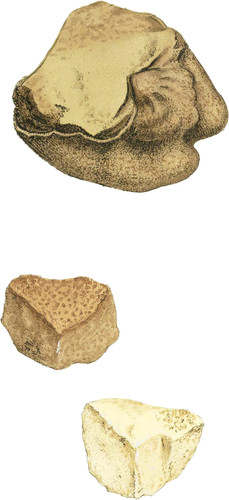 Enlarge
Enlarge
British Mineralogy
Magnesian Limestone
- Class 2. Earths.
- Order 1. Homogeneous.
- Gen. 3. Calx.
- Spec. 5. Carbonata.
- Var. Magnesiata.
- Div. 1. Crystallized.
- Syn. Magnesian Limestone. Tennant in Phil. Trans. 1799, part 2.
Mr. Tennant having favoured me with specimens of the stones spoken of in the Philosophical Transactions for 1799, I feel a pleasure in presenting so useful a subject to the public under such authentic circumstances.
The upper figure is what may be called the petrified remains of a shell, and is of a remarkable construction, especially on the hinge end. It has something of the appearance of an Arca, but is very different, however, from any that I have before seen, either petrified or recent. It was a curious circumstance that caused Mr. Tennant’s investigation of the nature of these Limestones; for he observed in Mr. Marshall’s Account of the Agriculture of the Midland Counties, that the Limestone found at Breden, near Derby, is destructive to vegetation. His experiments confirmed this account; and he found it to depend on the Magnesia, of which it seems that this Limestone contains about a fourth part. He further remarks, on the authority of Dr. Fenwick of Newcastle, that the farmers in that country divide the Limestones into hot and mild. The former, he says, is no doubt magnesian, as it has similar effects on the soil, and is not so easily dissolved in nitric acid as the latter*. A little better acquaintance with these substances may make them known without analysis; and I have little doubt but that the farmers and their men, in the neighbourhood of the hot and mild Limestone, have some more or less intelligent way of distinguishing the one from the other, so as not to mistake—as lapidaries can tell white Agates from white Carnelians, although they confess they cannot tell how. The present specimens have a granular appearance , and, upon careful examination, are found to contain, or are indeed almost wholly formed of, little crystals agreeing more or less with the more perfect Pearl-spar—see tab. 19—and show the rhomboidal sides sometimes tolerably distinct†. The shell at the top of the plate, and the brownish piece in the middle, from Breden, as also the whiter piece below, have in these particulars the same structure.
- * One of the properties of Magnesian Limestone is its slow solution in Nitric Acid.
- † Thus Mr. Tennant has discovered Pearl-spar to contain Magnesia; which in part corrects Bergman’s analysis of that substance, whence so many mistakes have arisen. Heavy Limestone or Dolomite of Tirie he finds to contain Magnesia in a larger proportion than above.

